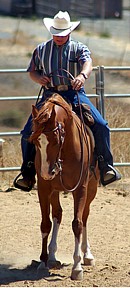|
Art Gallery (Horse Art) |
|
|
|
|
|
|||
|
A horse earns the title of “Gentle To Ride” by learning a set of what I call Basic Skills. Achieving these basic skills, in most cases, prepares the horse to advance to any specialized discipline whether dressage, jumping, reining, roping, endurance riding or trail riding. Is your horse gentle to ride? The response might be, “Well -- he doesn't buck me off, he turns and stops when I ask -- yes, he is Gentle to Ride.” Everyone has his or her own definition. My goal is to challenge you, to promote your thought, encourage you to explore new concepts and techniques and to think outside the box. A friend, Jack Adams, once told me, "It is so easy to train a horse, that it is difficult." Over twenty years later I saw him at a horse show. I told him he had been the one who had made the difference in how I worked with my horse and he said, "It put you on the right road." Enjoy the journey as you search for the "right road" while preparing your horse to be “Gentle To Ride.” Training my own horses and occasionally training for others has been my passion for many years. Experience has led me to recognize that horses and humans communicate in markedly different ways. Humans are very intellectual and can think in the “gray areas.” Horses, on the other hand, are not intellectual beings, they think entirely in black or white and there are no intellectual or "gray areas." This difference explains why it is so difficult for us to communicate simply, clearly and accurately with the horse. Therefore, it is paramount we change our thought process in order for the horse to understand what in the world we want. Yes, we must go to them, not the reverse. In other words, we must learn how they
learn and use what is easy for them. It is not their job to learn
how we train. I continually search for a better way to communicate
with my horse in all areas, on the ground or in the saddle. Maybe
tomorrow, next month or next year I will discover another new
method of preparing my horse. The horse's preparation or training will vary depending on a rider's philosophy and knowledge, riding environment, type of riding, whether English or Western and/or if a certain timeline is placed upon the horse such as a futurity. A horse being prepared as a rope horse will probably have a rope swung, an object dragged and a future jumping horse will probably trot over civilities. The rate of skill accomplishment depends not only on the knowledge and proficiency of the rider, but on the nature of the horse, number of (training) rides per week and the degree of refinement of each skill. Skill sequence does not necessarily follow a particular order and they can be taught either under saddle or on the ground, as the need arises. Groundwork skills are achieved using a halter and lead, while all the riding skills can be completed in a snaffle bit. It is reasonable to say all the skill training can be accomplished in three to five months. The horse learns by his errors, repetition, reward-release, work and rider consistency. Rushing skill development faster than the horse can learn will often result in a void or gap in his basic learning foundation that will surface later in his preparation. Backtracking from the “hard spot” or point of difficulty to discover the void takes extra time which could have been avoided had the rider not overlooked the skill earlier. Rather than backtracking, it is quite common for a rider to “address” or “correct” these “hard spots” with some form of restraint device, a more severe bit or by overpowering him. Whereas, identifying the missing link in the maneuver and developing that link would be the best approach to correcting the “hard spot.” As skill training proceeds, learning plateaus will occur naturally; however, the rider must not become complacent as it will inhibit the horse's progress. Steady, forward progress must be kept in mind. There is a potential to hurry, skip, and/or not recognize how missing one skill can change the total picture of preparing the horse. Therefore, the rider should guard against being in a hurry or getting lost---“the slow way is the fast way.” The horse is a herd animal, a creature of habit, an animal of flight; yet he is curious about what scares him and he wants to be comfortable. Often riders will focus on one or two of these natural traits or characteristics during training. Savvy and understanding of these traits will enable the rider to know when, where and how to apply them to a specific preparation technique. By using one or more of the horse's natural traits, the rider is able to steadily advance his horse towards the accomplishment of a specific skill. One “pitfall” a rider can encounter is riding a green or new horse with a group of friends. There is great value in riding alone because the distraction by other horses and riders will impede the horse's understanding that the rider is his leader. By riding alone, a horse's self-confidence, independence and skill development will begin to expand. Throughout this one-on-one time the rider should remember to be consistent, read his horse, make all communication clear, go slow, wait, practice patience and ”Keep It Simple”. |
|||
|
Skills
|
|||
|
When the horse accomplishes these general education skills, he is then in a position to become a good candidate for more specialized events like dressage, reining and so forth. A specific discipline will determine how adequately the horse is prepared ranging from well to poor and if he is ready to continue. Let us assume he is ready to move forward. Always keep in mind that at some point in the future he may not possess the natural talent necessary to advance in the discipline of choice. He may be better suited for another field of development; however, all things considered, he still should be a nice horse for personal enjoyment. There is truth in what Winston Churchill said, “There is something about the outside of a horse that is good for man.” After all, don't most of us have horses because we like them? I like my horses and want all of them to be “Gentle To Ride.” |


